Human Resource Management Report: Austin Fraser Case Study Analysis
VerifiedAdded on 2020/06/06
|14
|4794
|131
Report
AI Summary
This report offers a comprehensive analysis of Human Resource Management (HRM) practices within the context of Austin Fraser, a recruitment and staffing consultancy firm. It begins by defining HRM and outlining its core functions, such as planning, organizing, directing, and controlling, highlighting their significance for organizational growth and employee development. The report then delves into the strengths and weaknesses of various recruitment and selection approaches, including internal, external, and third-party sourcing, evaluating their impact on the firm's performance. Furthermore, the report examines the benefits of HRM practices for both management and employees, emphasizing the importance of effective strategies, employee safety, compensation, training, and employee satisfaction. It also discusses the role of employee relations and employment legislation in HRM decision-making, culminating in an application of these practices within a work-related context. Overall, the report underscores the crucial role of HRM in achieving organizational goals and fostering a positive work environment.
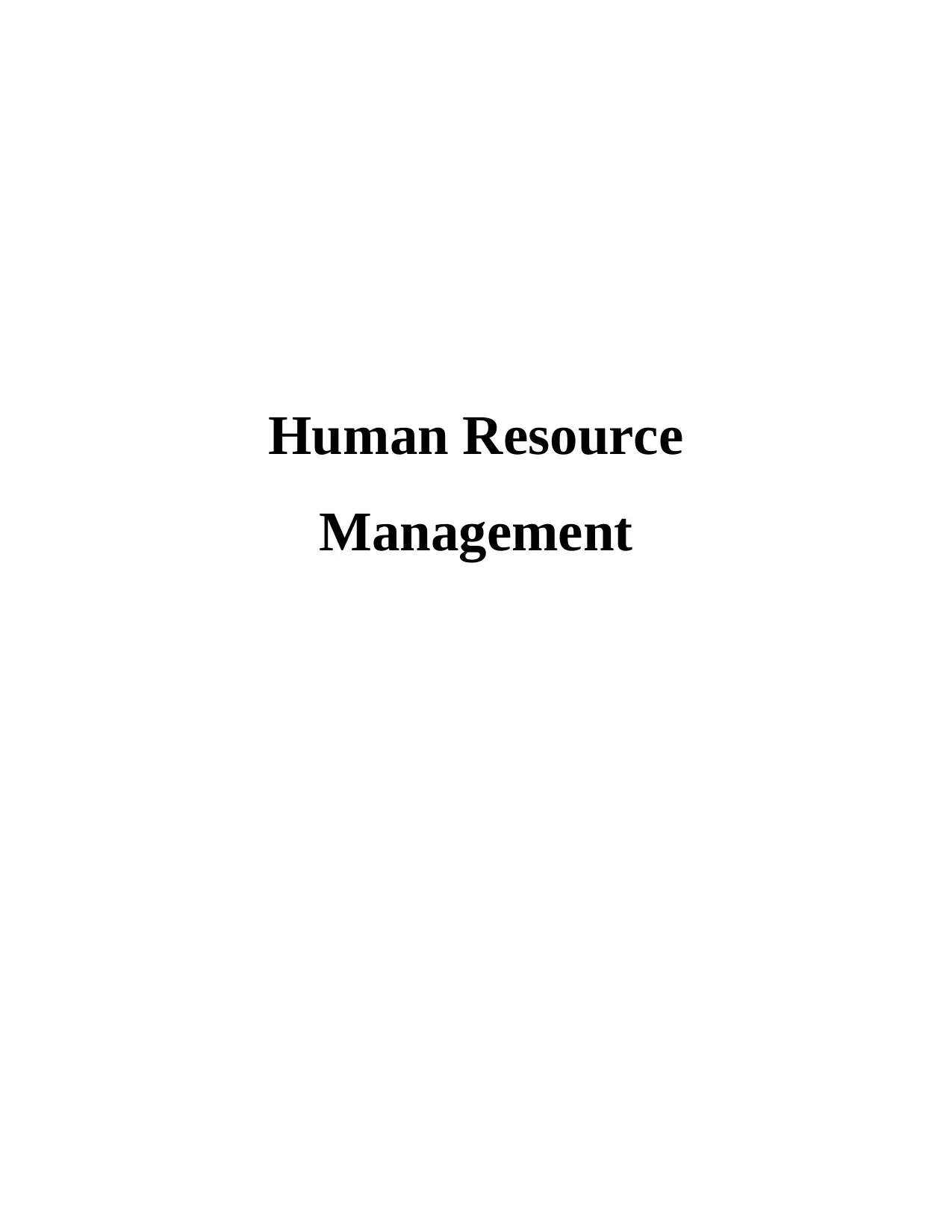
Human Resource
Management
Management
Paraphrase This Document
Need a fresh take? Get an instant paraphrase of this document with our AI Paraphraser
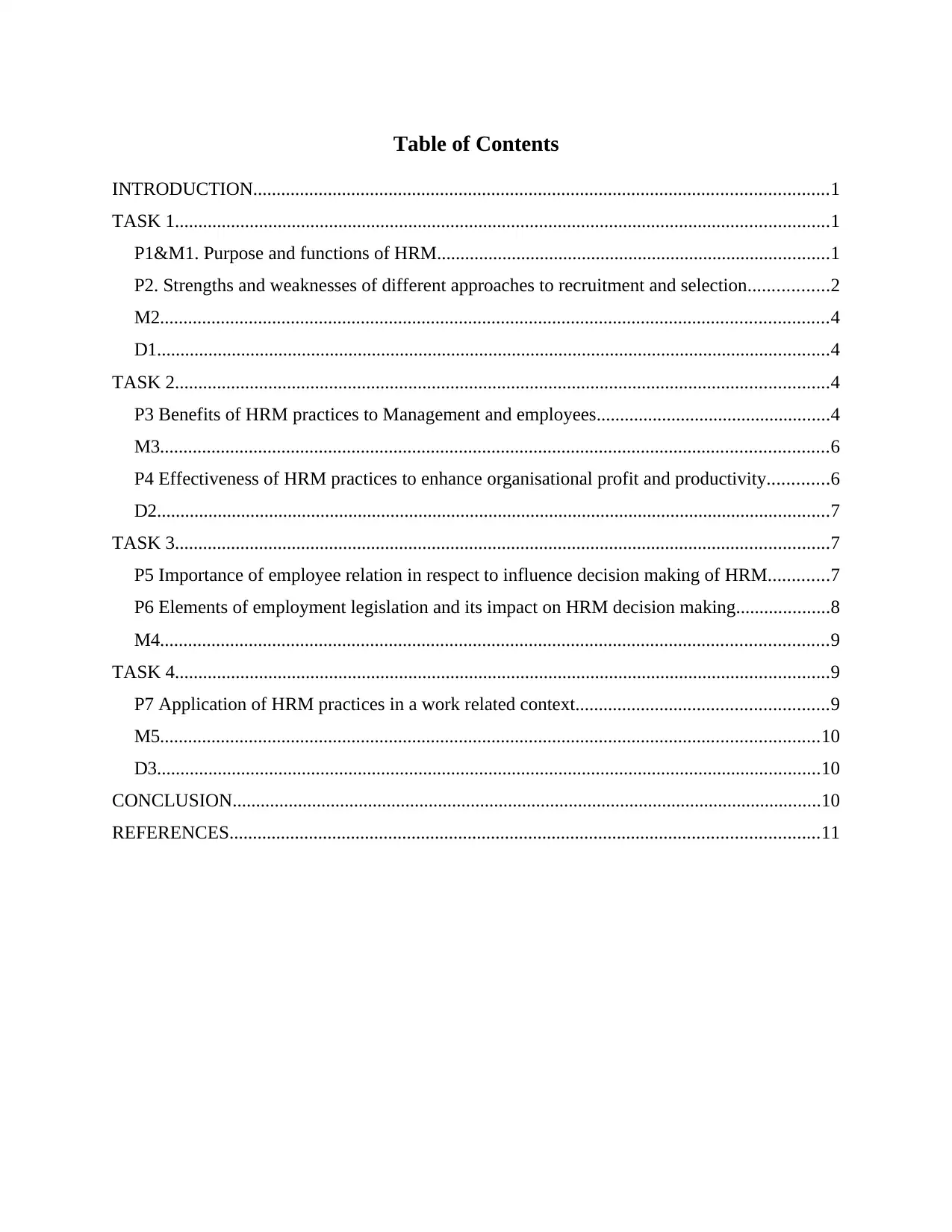
Table of Contents
INTRODUCTION...........................................................................................................................1
TASK 1............................................................................................................................................1
P1&M1. Purpose and functions of HRM....................................................................................1
P2. Strengths and weaknesses of different approaches to recruitment and selection.................2
M2...............................................................................................................................................4
D1................................................................................................................................................4
TASK 2............................................................................................................................................4
P3 Benefits of HRM practices to Management and employees..................................................4
M3...............................................................................................................................................6
P4 Effectiveness of HRM practices to enhance organisational profit and productivity.............6
D2................................................................................................................................................7
TASK 3............................................................................................................................................7
P5 Importance of employee relation in respect to influence decision making of HRM.............7
P6 Elements of employment legislation and its impact on HRM decision making....................8
M4...............................................................................................................................................9
TASK 4............................................................................................................................................9
P7 Application of HRM practices in a work related context......................................................9
M5.............................................................................................................................................10
D3..............................................................................................................................................10
CONCLUSION..............................................................................................................................10
REFERENCES..............................................................................................................................11
INTRODUCTION...........................................................................................................................1
TASK 1............................................................................................................................................1
P1&M1. Purpose and functions of HRM....................................................................................1
P2. Strengths and weaknesses of different approaches to recruitment and selection.................2
M2...............................................................................................................................................4
D1................................................................................................................................................4
TASK 2............................................................................................................................................4
P3 Benefits of HRM practices to Management and employees..................................................4
M3...............................................................................................................................................6
P4 Effectiveness of HRM practices to enhance organisational profit and productivity.............6
D2................................................................................................................................................7
TASK 3............................................................................................................................................7
P5 Importance of employee relation in respect to influence decision making of HRM.............7
P6 Elements of employment legislation and its impact on HRM decision making....................8
M4...............................................................................................................................................9
TASK 4............................................................................................................................................9
P7 Application of HRM practices in a work related context......................................................9
M5.............................................................................................................................................10
D3..............................................................................................................................................10
CONCLUSION..............................................................................................................................10
REFERENCES..............................................................................................................................11
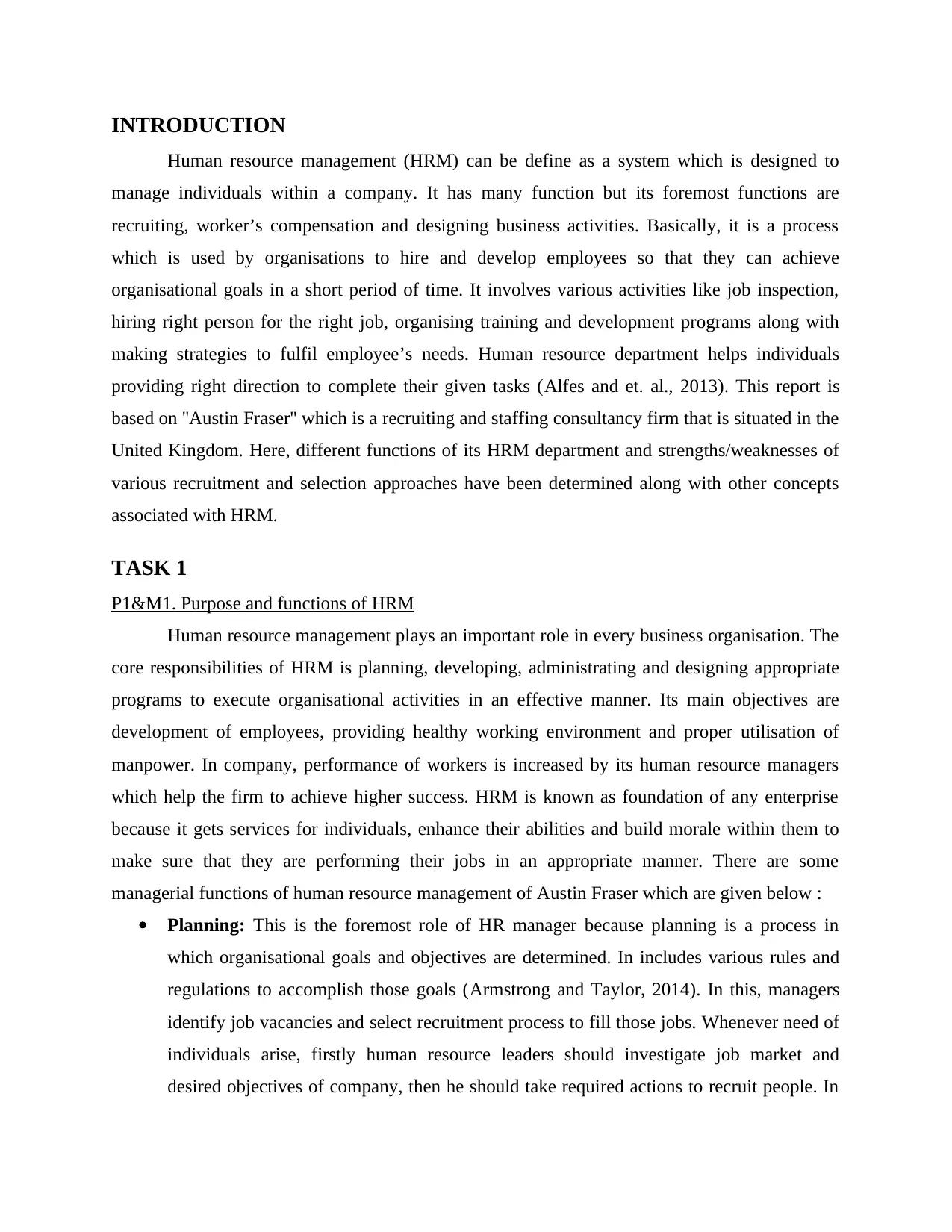
INTRODUCTION
Human resource management (HRM) can be define as a system which is designed to
manage individuals within a company. It has many function but its foremost functions are
recruiting, worker’s compensation and designing business activities. Basically, it is a process
which is used by organisations to hire and develop employees so that they can achieve
organisational goals in a short period of time. It involves various activities like job inspection,
hiring right person for the right job, organising training and development programs along with
making strategies to fulfil employee’s needs. Human resource department helps individuals
providing right direction to complete their given tasks (Alfes and et. al., 2013). This report is
based on ''Austin Fraser'' which is a recruiting and staffing consultancy firm that is situated in the
United Kingdom. Here, different functions of its HRM department and strengths/weaknesses of
various recruitment and selection approaches have been determined along with other concepts
associated with HRM.
TASK 1
P1&M1. Purpose and functions of HRM
Human resource management plays an important role in every business organisation. The
core responsibilities of HRM is planning, developing, administrating and designing appropriate
programs to execute organisational activities in an effective manner. Its main objectives are
development of employees, providing healthy working environment and proper utilisation of
manpower. In company, performance of workers is increased by its human resource managers
which help the firm to achieve higher success. HRM is known as foundation of any enterprise
because it gets services for individuals, enhance their abilities and build morale within them to
make sure that they are performing their jobs in an appropriate manner. There are some
managerial functions of human resource management of Austin Fraser which are given below :
Planning: This is the foremost role of HR manager because planning is a process in
which organisational goals and objectives are determined. In includes various rules and
regulations to accomplish those goals (Armstrong and Taylor, 2014). In this, managers
identify job vacancies and select recruitment process to fill those jobs. Whenever need of
individuals arise, firstly human resource leaders should investigate job market and
desired objectives of company, then he should take required actions to recruit people. In
Human resource management (HRM) can be define as a system which is designed to
manage individuals within a company. It has many function but its foremost functions are
recruiting, worker’s compensation and designing business activities. Basically, it is a process
which is used by organisations to hire and develop employees so that they can achieve
organisational goals in a short period of time. It involves various activities like job inspection,
hiring right person for the right job, organising training and development programs along with
making strategies to fulfil employee’s needs. Human resource department helps individuals
providing right direction to complete their given tasks (Alfes and et. al., 2013). This report is
based on ''Austin Fraser'' which is a recruiting and staffing consultancy firm that is situated in the
United Kingdom. Here, different functions of its HRM department and strengths/weaknesses of
various recruitment and selection approaches have been determined along with other concepts
associated with HRM.
TASK 1
P1&M1. Purpose and functions of HRM
Human resource management plays an important role in every business organisation. The
core responsibilities of HRM is planning, developing, administrating and designing appropriate
programs to execute organisational activities in an effective manner. Its main objectives are
development of employees, providing healthy working environment and proper utilisation of
manpower. In company, performance of workers is increased by its human resource managers
which help the firm to achieve higher success. HRM is known as foundation of any enterprise
because it gets services for individuals, enhance their abilities and build morale within them to
make sure that they are performing their jobs in an appropriate manner. There are some
managerial functions of human resource management of Austin Fraser which are given below :
Planning: This is the foremost role of HR manager because planning is a process in
which organisational goals and objectives are determined. In includes various rules and
regulations to accomplish those goals (Armstrong and Taylor, 2014). In this, managers
identify job vacancies and select recruitment process to fill those jobs. Whenever need of
individuals arise, firstly human resource leaders should investigate job market and
desired objectives of company, then he should take required actions to recruit people. In
⊘ This is a preview!⊘
Do you want full access?
Subscribe today to unlock all pages.

Trusted by 1+ million students worldwide
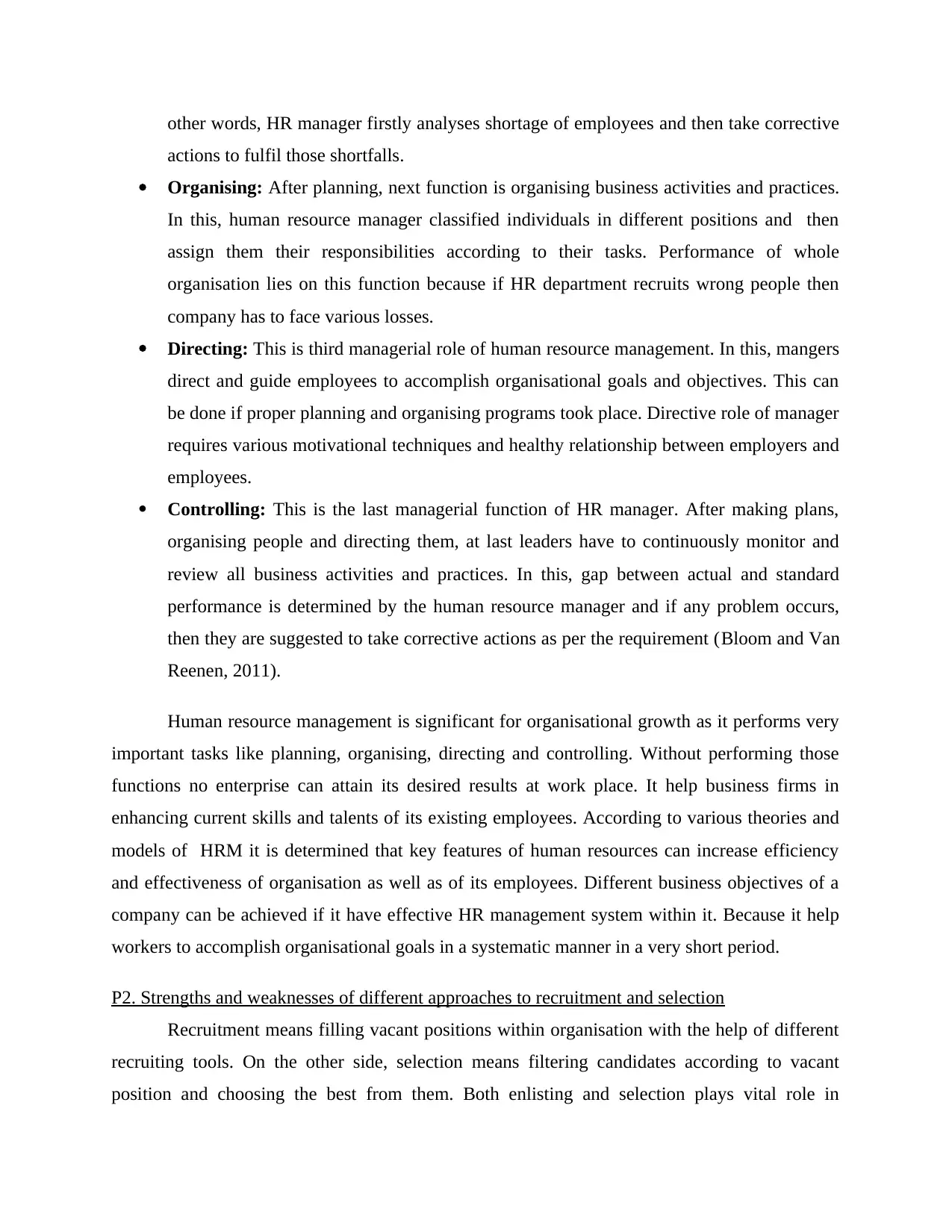
other words, HR manager firstly analyses shortage of employees and then take corrective
actions to fulfil those shortfalls.
Organising: After planning, next function is organising business activities and practices.
In this, human resource manager classified individuals in different positions and then
assign them their responsibilities according to their tasks. Performance of whole
organisation lies on this function because if HR department recruits wrong people then
company has to face various losses.
Directing: This is third managerial role of human resource management. In this, mangers
direct and guide employees to accomplish organisational goals and objectives. This can
be done if proper planning and organising programs took place. Directive role of manager
requires various motivational techniques and healthy relationship between employers and
employees.
Controlling: This is the last managerial function of HR manager. After making plans,
organising people and directing them, at last leaders have to continuously monitor and
review all business activities and practices. In this, gap between actual and standard
performance is determined by the human resource manager and if any problem occurs,
then they are suggested to take corrective actions as per the requirement (Bloom and Van
Reenen, 2011).
Human resource management is significant for organisational growth as it performs very
important tasks like planning, organising, directing and controlling. Without performing those
functions no enterprise can attain its desired results at work place. It help business firms in
enhancing current skills and talents of its existing employees. According to various theories and
models of HRM it is determined that key features of human resources can increase efficiency
and effectiveness of organisation as well as of its employees. Different business objectives of a
company can be achieved if it have effective HR management system within it. Because it help
workers to accomplish organisational goals in a systematic manner in a very short period.
P2. Strengths and weaknesses of different approaches to recruitment and selection
Recruitment means filling vacant positions within organisation with the help of different
recruiting tools. On the other side, selection means filtering candidates according to vacant
position and choosing the best from them. Both enlisting and selection plays vital role in
actions to fulfil those shortfalls.
Organising: After planning, next function is organising business activities and practices.
In this, human resource manager classified individuals in different positions and then
assign them their responsibilities according to their tasks. Performance of whole
organisation lies on this function because if HR department recruits wrong people then
company has to face various losses.
Directing: This is third managerial role of human resource management. In this, mangers
direct and guide employees to accomplish organisational goals and objectives. This can
be done if proper planning and organising programs took place. Directive role of manager
requires various motivational techniques and healthy relationship between employers and
employees.
Controlling: This is the last managerial function of HR manager. After making plans,
organising people and directing them, at last leaders have to continuously monitor and
review all business activities and practices. In this, gap between actual and standard
performance is determined by the human resource manager and if any problem occurs,
then they are suggested to take corrective actions as per the requirement (Bloom and Van
Reenen, 2011).
Human resource management is significant for organisational growth as it performs very
important tasks like planning, organising, directing and controlling. Without performing those
functions no enterprise can attain its desired results at work place. It help business firms in
enhancing current skills and talents of its existing employees. According to various theories and
models of HRM it is determined that key features of human resources can increase efficiency
and effectiveness of organisation as well as of its employees. Different business objectives of a
company can be achieved if it have effective HR management system within it. Because it help
workers to accomplish organisational goals in a systematic manner in a very short period.
P2. Strengths and weaknesses of different approaches to recruitment and selection
Recruitment means filling vacant positions within organisation with the help of different
recruiting tools. On the other side, selection means filtering candidates according to vacant
position and choosing the best from them. Both enlisting and selection plays vital role in
Paraphrase This Document
Need a fresh take? Get an instant paraphrase of this document with our AI Paraphraser
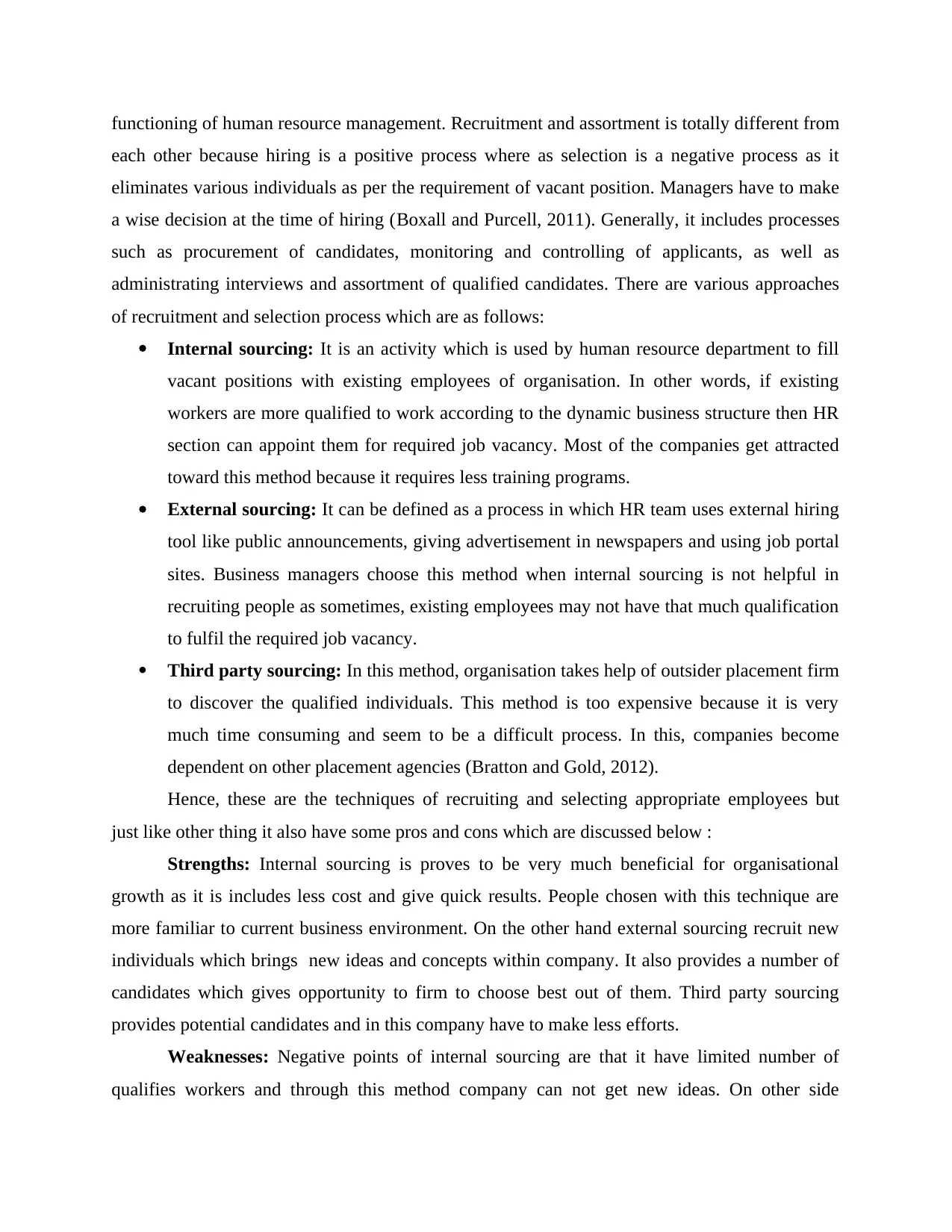
functioning of human resource management. Recruitment and assortment is totally different from
each other because hiring is a positive process where as selection is a negative process as it
eliminates various individuals as per the requirement of vacant position. Managers have to make
a wise decision at the time of hiring (Boxall and Purcell, 2011). Generally, it includes processes
such as procurement of candidates, monitoring and controlling of applicants, as well as
administrating interviews and assortment of qualified candidates. There are various approaches
of recruitment and selection process which are as follows:
Internal sourcing: It is an activity which is used by human resource department to fill
vacant positions with existing employees of organisation. In other words, if existing
workers are more qualified to work according to the dynamic business structure then HR
section can appoint them for required job vacancy. Most of the companies get attracted
toward this method because it requires less training programs.
External sourcing: It can be defined as a process in which HR team uses external hiring
tool like public announcements, giving advertisement in newspapers and using job portal
sites. Business managers choose this method when internal sourcing is not helpful in
recruiting people as sometimes, existing employees may not have that much qualification
to fulfil the required job vacancy.
Third party sourcing: In this method, organisation takes help of outsider placement firm
to discover the qualified individuals. This method is too expensive because it is very
much time consuming and seem to be a difficult process. In this, companies become
dependent on other placement agencies (Bratton and Gold, 2012).
Hence, these are the techniques of recruiting and selecting appropriate employees but
just like other thing it also have some pros and cons which are discussed below :
Strengths: Internal sourcing is proves to be very much beneficial for organisational
growth as it is includes less cost and give quick results. People chosen with this technique are
more familiar to current business environment. On the other hand external sourcing recruit new
individuals which brings new ideas and concepts within company. It also provides a number of
candidates which gives opportunity to firm to choose best out of them. Third party sourcing
provides potential candidates and in this company have to make less efforts.
Weaknesses: Negative points of internal sourcing are that it have limited number of
qualifies workers and through this method company can not get new ideas. On other side
each other because hiring is a positive process where as selection is a negative process as it
eliminates various individuals as per the requirement of vacant position. Managers have to make
a wise decision at the time of hiring (Boxall and Purcell, 2011). Generally, it includes processes
such as procurement of candidates, monitoring and controlling of applicants, as well as
administrating interviews and assortment of qualified candidates. There are various approaches
of recruitment and selection process which are as follows:
Internal sourcing: It is an activity which is used by human resource department to fill
vacant positions with existing employees of organisation. In other words, if existing
workers are more qualified to work according to the dynamic business structure then HR
section can appoint them for required job vacancy. Most of the companies get attracted
toward this method because it requires less training programs.
External sourcing: It can be defined as a process in which HR team uses external hiring
tool like public announcements, giving advertisement in newspapers and using job portal
sites. Business managers choose this method when internal sourcing is not helpful in
recruiting people as sometimes, existing employees may not have that much qualification
to fulfil the required job vacancy.
Third party sourcing: In this method, organisation takes help of outsider placement firm
to discover the qualified individuals. This method is too expensive because it is very
much time consuming and seem to be a difficult process. In this, companies become
dependent on other placement agencies (Bratton and Gold, 2012).
Hence, these are the techniques of recruiting and selecting appropriate employees but
just like other thing it also have some pros and cons which are discussed below :
Strengths: Internal sourcing is proves to be very much beneficial for organisational
growth as it is includes less cost and give quick results. People chosen with this technique are
more familiar to current business environment. On the other hand external sourcing recruit new
individuals which brings new ideas and concepts within company. It also provides a number of
candidates which gives opportunity to firm to choose best out of them. Third party sourcing
provides potential candidates and in this company have to make less efforts.
Weaknesses: Negative points of internal sourcing are that it have limited number of
qualifies workers and through this method company can not get new ideas. On other side
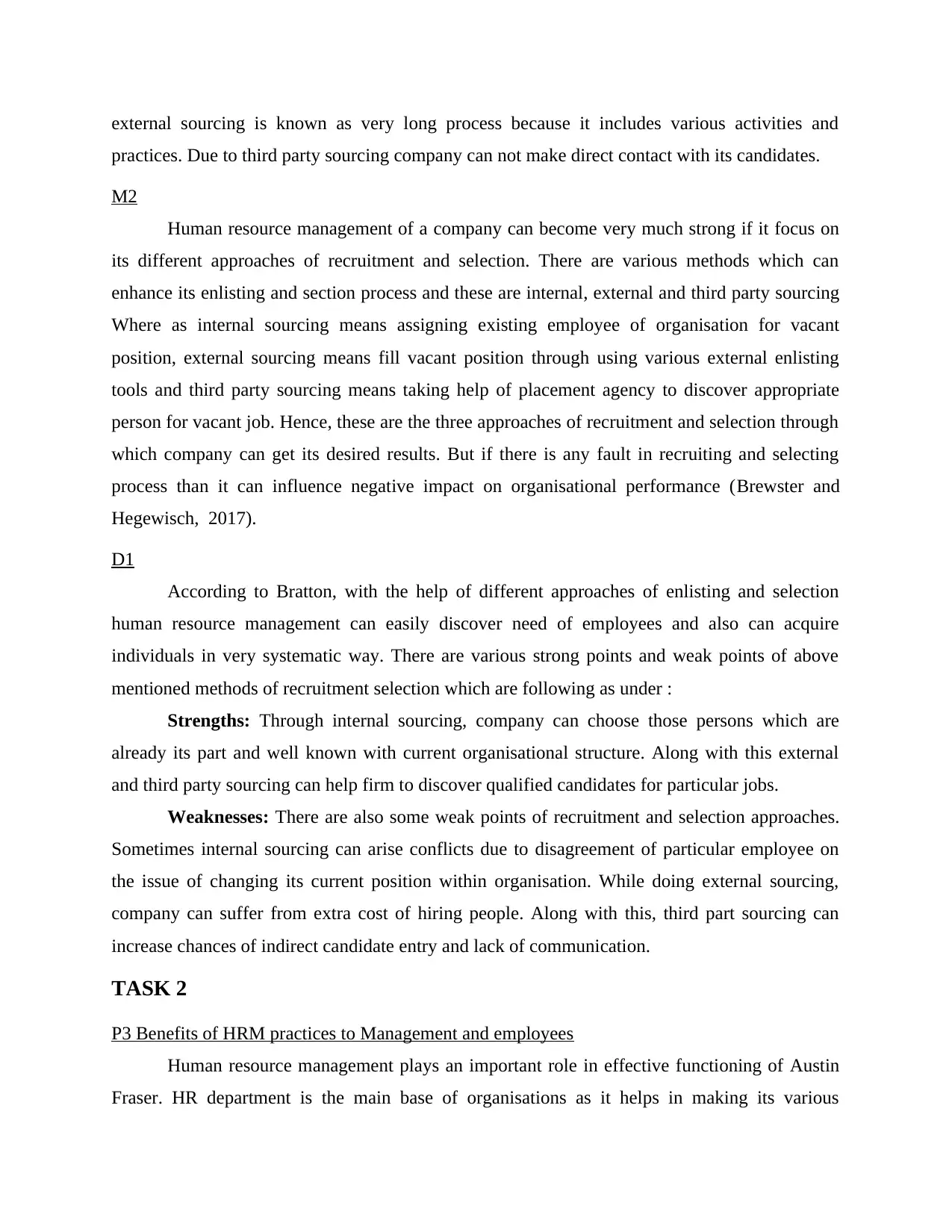
external sourcing is known as very long process because it includes various activities and
practices. Due to third party sourcing company can not make direct contact with its candidates.
M2
Human resource management of a company can become very much strong if it focus on
its different approaches of recruitment and selection. There are various methods which can
enhance its enlisting and section process and these are internal, external and third party sourcing
Where as internal sourcing means assigning existing employee of organisation for vacant
position, external sourcing means fill vacant position through using various external enlisting
tools and third party sourcing means taking help of placement agency to discover appropriate
person for vacant job. Hence, these are the three approaches of recruitment and selection through
which company can get its desired results. But if there is any fault in recruiting and selecting
process than it can influence negative impact on organisational performance (Brewster and
Hegewisch, 2017).
D1
According to Bratton, with the help of different approaches of enlisting and selection
human resource management can easily discover need of employees and also can acquire
individuals in very systematic way. There are various strong points and weak points of above
mentioned methods of recruitment selection which are following as under :
Strengths: Through internal sourcing, company can choose those persons which are
already its part and well known with current organisational structure. Along with this external
and third party sourcing can help firm to discover qualified candidates for particular jobs.
Weaknesses: There are also some weak points of recruitment and selection approaches.
Sometimes internal sourcing can arise conflicts due to disagreement of particular employee on
the issue of changing its current position within organisation. While doing external sourcing,
company can suffer from extra cost of hiring people. Along with this, third part sourcing can
increase chances of indirect candidate entry and lack of communication.
TASK 2
P3 Benefits of HRM practices to Management and employees
Human resource management plays an important role in effective functioning of Austin
Fraser. HR department is the main base of organisations as it helps in making its various
practices. Due to third party sourcing company can not make direct contact with its candidates.
M2
Human resource management of a company can become very much strong if it focus on
its different approaches of recruitment and selection. There are various methods which can
enhance its enlisting and section process and these are internal, external and third party sourcing
Where as internal sourcing means assigning existing employee of organisation for vacant
position, external sourcing means fill vacant position through using various external enlisting
tools and third party sourcing means taking help of placement agency to discover appropriate
person for vacant job. Hence, these are the three approaches of recruitment and selection through
which company can get its desired results. But if there is any fault in recruiting and selecting
process than it can influence negative impact on organisational performance (Brewster and
Hegewisch, 2017).
D1
According to Bratton, with the help of different approaches of enlisting and selection
human resource management can easily discover need of employees and also can acquire
individuals in very systematic way. There are various strong points and weak points of above
mentioned methods of recruitment selection which are following as under :
Strengths: Through internal sourcing, company can choose those persons which are
already its part and well known with current organisational structure. Along with this external
and third party sourcing can help firm to discover qualified candidates for particular jobs.
Weaknesses: There are also some weak points of recruitment and selection approaches.
Sometimes internal sourcing can arise conflicts due to disagreement of particular employee on
the issue of changing its current position within organisation. While doing external sourcing,
company can suffer from extra cost of hiring people. Along with this, third part sourcing can
increase chances of indirect candidate entry and lack of communication.
TASK 2
P3 Benefits of HRM practices to Management and employees
Human resource management plays an important role in effective functioning of Austin
Fraser. HR department is the main base of organisations as it helps in making its various
⊘ This is a preview!⊘
Do you want full access?
Subscribe today to unlock all pages.

Trusted by 1+ million students worldwide
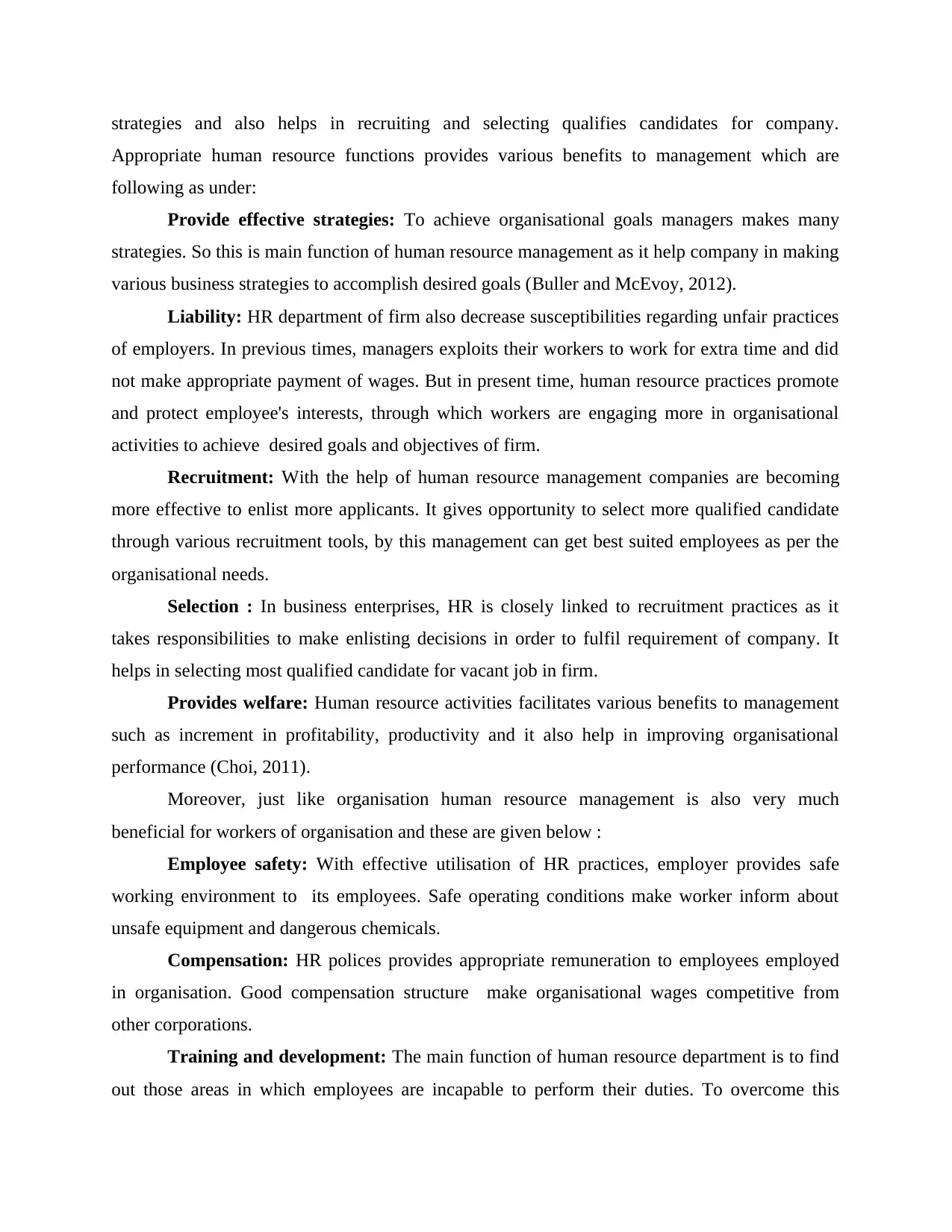
strategies and also helps in recruiting and selecting qualifies candidates for company.
Appropriate human resource functions provides various benefits to management which are
following as under:
Provide effective strategies: To achieve organisational goals managers makes many
strategies. So this is main function of human resource management as it help company in making
various business strategies to accomplish desired goals (Buller and McEvoy, 2012).
Liability: HR department of firm also decrease susceptibilities regarding unfair practices
of employers. In previous times, managers exploits their workers to work for extra time and did
not make appropriate payment of wages. But in present time, human resource practices promote
and protect employee's interests, through which workers are engaging more in organisational
activities to achieve desired goals and objectives of firm.
Recruitment: With the help of human resource management companies are becoming
more effective to enlist more applicants. It gives opportunity to select more qualified candidate
through various recruitment tools, by this management can get best suited employees as per the
organisational needs.
Selection : In business enterprises, HR is closely linked to recruitment practices as it
takes responsibilities to make enlisting decisions in order to fulfil requirement of company. It
helps in selecting most qualified candidate for vacant job in firm.
Provides welfare: Human resource activities facilitates various benefits to management
such as increment in profitability, productivity and it also help in improving organisational
performance (Choi, 2011).
Moreover, just like organisation human resource management is also very much
beneficial for workers of organisation and these are given below :
Employee safety: With effective utilisation of HR practices, employer provides safe
working environment to its employees. Safe operating conditions make worker inform about
unsafe equipment and dangerous chemicals.
Compensation: HR polices provides appropriate remuneration to employees employed
in organisation. Good compensation structure make organisational wages competitive from
other corporations.
Training and development: The main function of human resource department is to find
out those areas in which employees are incapable to perform their duties. To overcome this
Appropriate human resource functions provides various benefits to management which are
following as under:
Provide effective strategies: To achieve organisational goals managers makes many
strategies. So this is main function of human resource management as it help company in making
various business strategies to accomplish desired goals (Buller and McEvoy, 2012).
Liability: HR department of firm also decrease susceptibilities regarding unfair practices
of employers. In previous times, managers exploits their workers to work for extra time and did
not make appropriate payment of wages. But in present time, human resource practices promote
and protect employee's interests, through which workers are engaging more in organisational
activities to achieve desired goals and objectives of firm.
Recruitment: With the help of human resource management companies are becoming
more effective to enlist more applicants. It gives opportunity to select more qualified candidate
through various recruitment tools, by this management can get best suited employees as per the
organisational needs.
Selection : In business enterprises, HR is closely linked to recruitment practices as it
takes responsibilities to make enlisting decisions in order to fulfil requirement of company. It
helps in selecting most qualified candidate for vacant job in firm.
Provides welfare: Human resource activities facilitates various benefits to management
such as increment in profitability, productivity and it also help in improving organisational
performance (Choi, 2011).
Moreover, just like organisation human resource management is also very much
beneficial for workers of organisation and these are given below :
Employee safety: With effective utilisation of HR practices, employer provides safe
working environment to its employees. Safe operating conditions make worker inform about
unsafe equipment and dangerous chemicals.
Compensation: HR polices provides appropriate remuneration to employees employed
in organisation. Good compensation structure make organisational wages competitive from
other corporations.
Training and development: The main function of human resource department is to find
out those areas in which employees are incapable to perform their duties. To overcome this
Paraphrase This Document
Need a fresh take? Get an instant paraphrase of this document with our AI Paraphraser
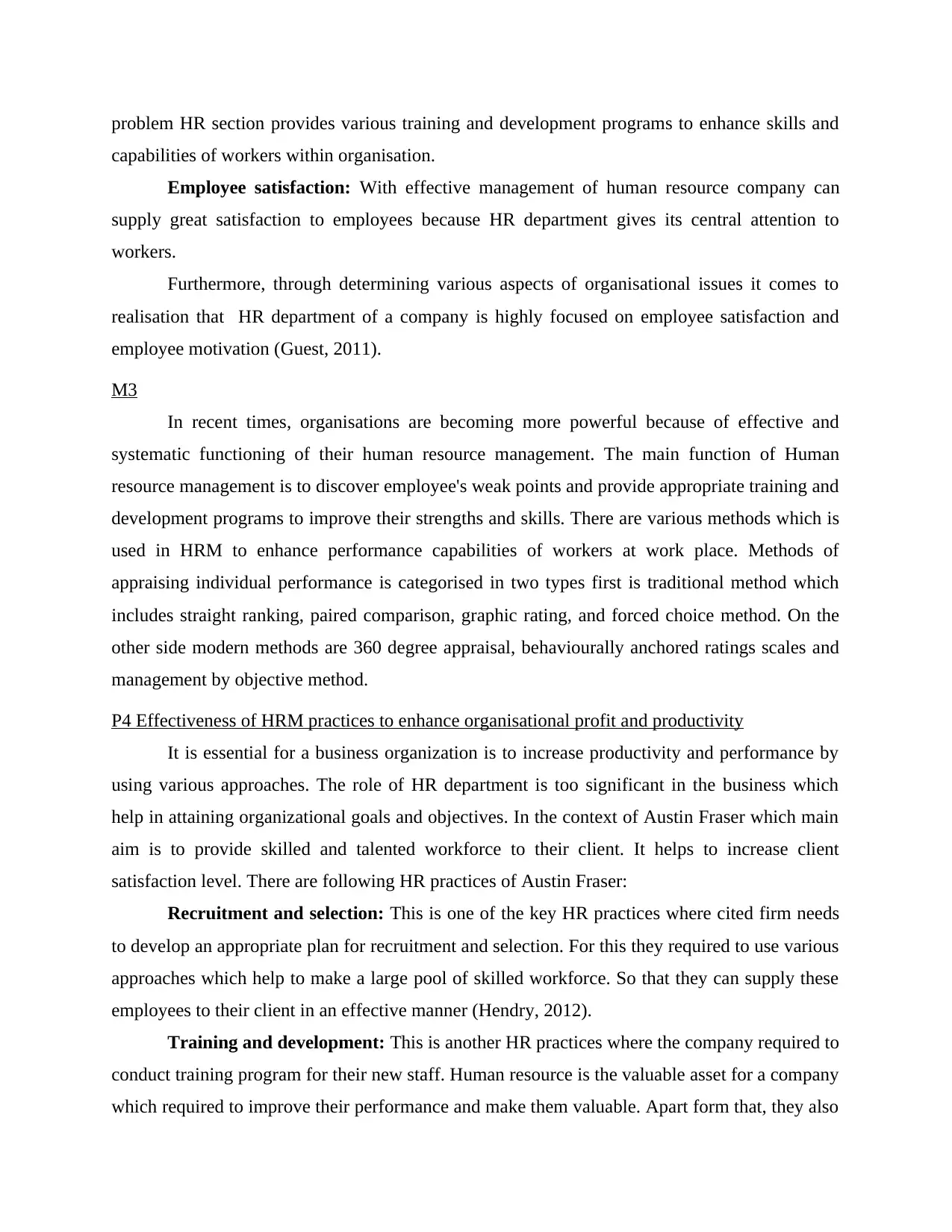
problem HR section provides various training and development programs to enhance skills and
capabilities of workers within organisation.
Employee satisfaction: With effective management of human resource company can
supply great satisfaction to employees because HR department gives its central attention to
workers.
Furthermore, through determining various aspects of organisational issues it comes to
realisation that HR department of a company is highly focused on employee satisfaction and
employee motivation (Guest, 2011).
M3
In recent times, organisations are becoming more powerful because of effective and
systematic functioning of their human resource management. The main function of Human
resource management is to discover employee's weak points and provide appropriate training and
development programs to improve their strengths and skills. There are various methods which is
used in HRM to enhance performance capabilities of workers at work place. Methods of
appraising individual performance is categorised in two types first is traditional method which
includes straight ranking, paired comparison, graphic rating, and forced choice method. On the
other side modern methods are 360 degree appraisal, behaviourally anchored ratings scales and
management by objective method.
P4 Effectiveness of HRM practices to enhance organisational profit and productivity
It is essential for a business organization is to increase productivity and performance by
using various approaches. The role of HR department is too significant in the business which
help in attaining organizational goals and objectives. In the context of Austin Fraser which main
aim is to provide skilled and talented workforce to their client. It helps to increase client
satisfaction level. There are following HR practices of Austin Fraser:
Recruitment and selection: This is one of the key HR practices where cited firm needs
to develop an appropriate plan for recruitment and selection. For this they required to use various
approaches which help to make a large pool of skilled workforce. So that they can supply these
employees to their client in an effective manner (Hendry, 2012).
Training and development: This is another HR practices where the company required to
conduct training program for their new staff. Human resource is the valuable asset for a company
which required to improve their performance and make them valuable. Apart form that, they also
capabilities of workers within organisation.
Employee satisfaction: With effective management of human resource company can
supply great satisfaction to employees because HR department gives its central attention to
workers.
Furthermore, through determining various aspects of organisational issues it comes to
realisation that HR department of a company is highly focused on employee satisfaction and
employee motivation (Guest, 2011).
M3
In recent times, organisations are becoming more powerful because of effective and
systematic functioning of their human resource management. The main function of Human
resource management is to discover employee's weak points and provide appropriate training and
development programs to improve their strengths and skills. There are various methods which is
used in HRM to enhance performance capabilities of workers at work place. Methods of
appraising individual performance is categorised in two types first is traditional method which
includes straight ranking, paired comparison, graphic rating, and forced choice method. On the
other side modern methods are 360 degree appraisal, behaviourally anchored ratings scales and
management by objective method.
P4 Effectiveness of HRM practices to enhance organisational profit and productivity
It is essential for a business organization is to increase productivity and performance by
using various approaches. The role of HR department is too significant in the business which
help in attaining organizational goals and objectives. In the context of Austin Fraser which main
aim is to provide skilled and talented workforce to their client. It helps to increase client
satisfaction level. There are following HR practices of Austin Fraser:
Recruitment and selection: This is one of the key HR practices where cited firm needs
to develop an appropriate plan for recruitment and selection. For this they required to use various
approaches which help to make a large pool of skilled workforce. So that they can supply these
employees to their client in an effective manner (Hendry, 2012).
Training and development: This is another HR practices where the company required to
conduct training program for their new staff. Human resource is the valuable asset for a company
which required to improve their performance and make them valuable. Apart form that, they also
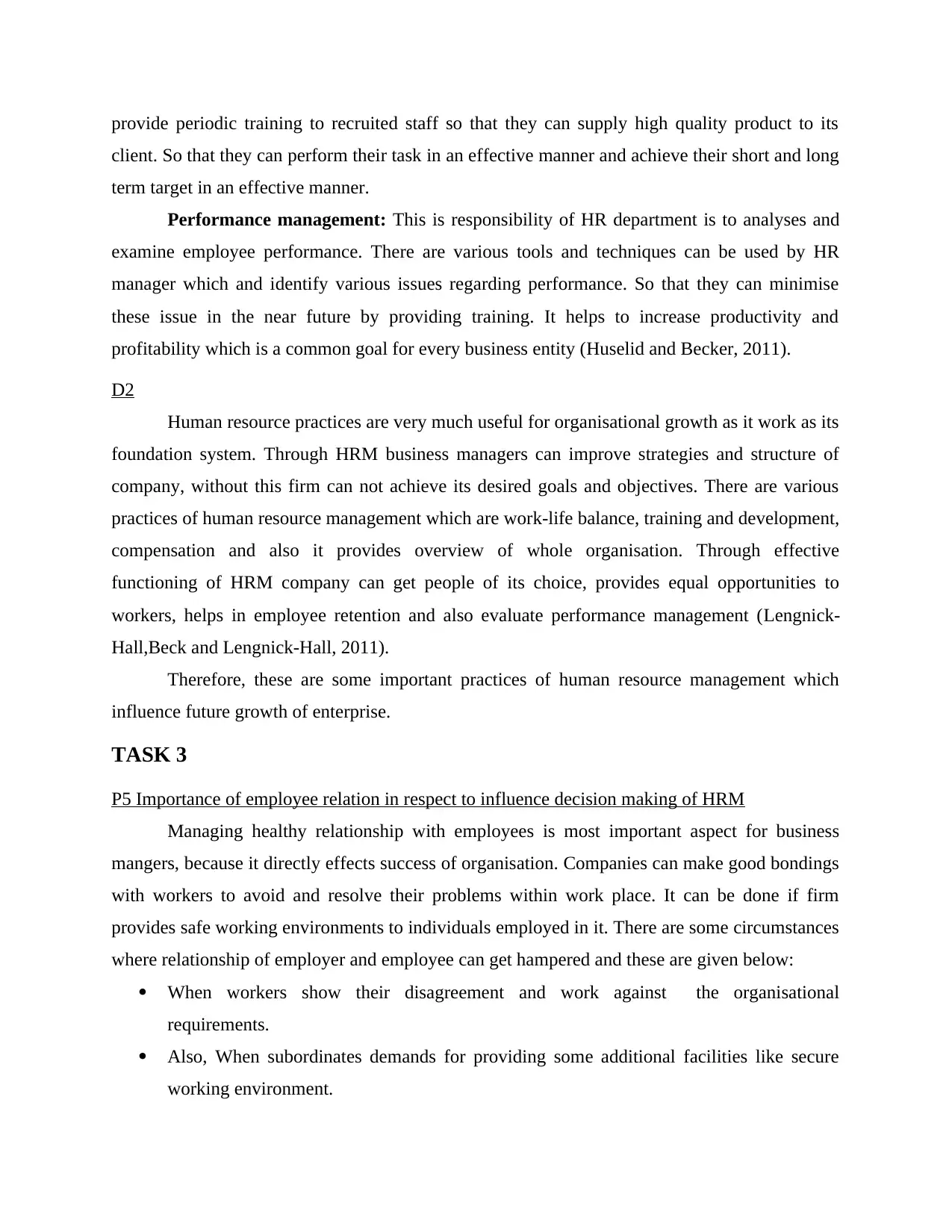
provide periodic training to recruited staff so that they can supply high quality product to its
client. So that they can perform their task in an effective manner and achieve their short and long
term target in an effective manner.
Performance management: This is responsibility of HR department is to analyses and
examine employee performance. There are various tools and techniques can be used by HR
manager which and identify various issues regarding performance. So that they can minimise
these issue in the near future by providing training. It helps to increase productivity and
profitability which is a common goal for every business entity (Huselid and Becker, 2011).
D2
Human resource practices are very much useful for organisational growth as it work as its
foundation system. Through HRM business managers can improve strategies and structure of
company, without this firm can not achieve its desired goals and objectives. There are various
practices of human resource management which are work-life balance, training and development,
compensation and also it provides overview of whole organisation. Through effective
functioning of HRM company can get people of its choice, provides equal opportunities to
workers, helps in employee retention and also evaluate performance management (Lengnick-
Hall,Beck and Lengnick-Hall, 2011).
Therefore, these are some important practices of human resource management which
influence future growth of enterprise.
TASK 3
P5 Importance of employee relation in respect to influence decision making of HRM
Managing healthy relationship with employees is most important aspect for business
mangers, because it directly effects success of organisation. Companies can make good bondings
with workers to avoid and resolve their problems within work place. It can be done if firm
provides safe working environments to individuals employed in it. There are some circumstances
where relationship of employer and employee can get hampered and these are given below:
When workers show their disagreement and work against the organisational
requirements.
Also, When subordinates demands for providing some additional facilities like secure
working environment.
client. So that they can perform their task in an effective manner and achieve their short and long
term target in an effective manner.
Performance management: This is responsibility of HR department is to analyses and
examine employee performance. There are various tools and techniques can be used by HR
manager which and identify various issues regarding performance. So that they can minimise
these issue in the near future by providing training. It helps to increase productivity and
profitability which is a common goal for every business entity (Huselid and Becker, 2011).
D2
Human resource practices are very much useful for organisational growth as it work as its
foundation system. Through HRM business managers can improve strategies and structure of
company, without this firm can not achieve its desired goals and objectives. There are various
practices of human resource management which are work-life balance, training and development,
compensation and also it provides overview of whole organisation. Through effective
functioning of HRM company can get people of its choice, provides equal opportunities to
workers, helps in employee retention and also evaluate performance management (Lengnick-
Hall,Beck and Lengnick-Hall, 2011).
Therefore, these are some important practices of human resource management which
influence future growth of enterprise.
TASK 3
P5 Importance of employee relation in respect to influence decision making of HRM
Managing healthy relationship with employees is most important aspect for business
mangers, because it directly effects success of organisation. Companies can make good bondings
with workers to avoid and resolve their problems within work place. It can be done if firm
provides safe working environments to individuals employed in it. There are some circumstances
where relationship of employer and employee can get hampered and these are given below:
When workers show their disagreement and work against the organisational
requirements.
Also, When subordinates demands for providing some additional facilities like secure
working environment.
⊘ This is a preview!⊘
Do you want full access?
Subscribe today to unlock all pages.

Trusted by 1+ million students worldwide
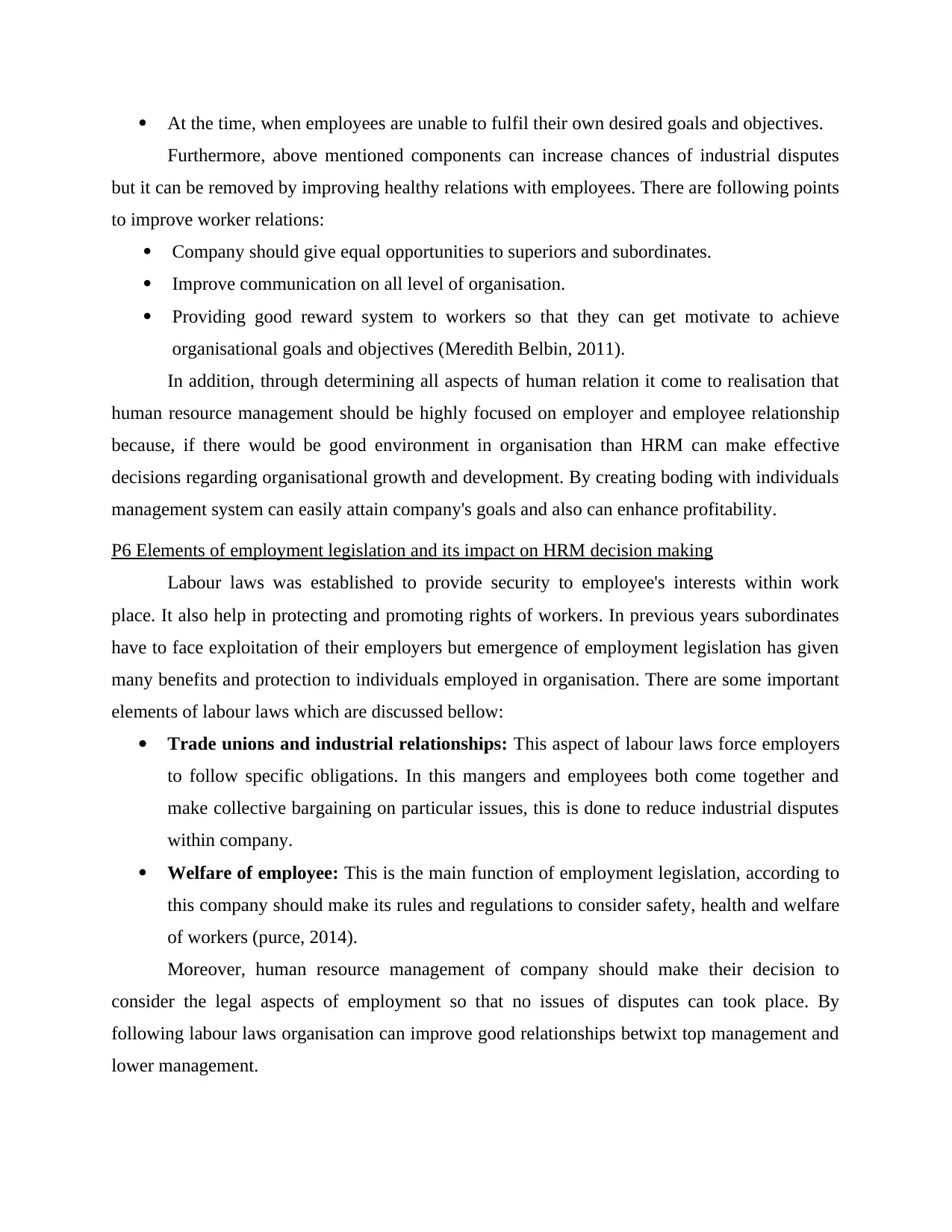
At the time, when employees are unable to fulfil their own desired goals and objectives.
Furthermore, above mentioned components can increase chances of industrial disputes
but it can be removed by improving healthy relations with employees. There are following points
to improve worker relations:
Company should give equal opportunities to superiors and subordinates.
Improve communication on all level of organisation.
Providing good reward system to workers so that they can get motivate to achieve
organisational goals and objectives (Meredith Belbin, 2011).
In addition, through determining all aspects of human relation it come to realisation that
human resource management should be highly focused on employer and employee relationship
because, if there would be good environment in organisation than HRM can make effective
decisions regarding organisational growth and development. By creating boding with individuals
management system can easily attain company's goals and also can enhance profitability.
P6 Elements of employment legislation and its impact on HRM decision making
Labour laws was established to provide security to employee's interests within work
place. It also help in protecting and promoting rights of workers. In previous years subordinates
have to face exploitation of their employers but emergence of employment legislation has given
many benefits and protection to individuals employed in organisation. There are some important
elements of labour laws which are discussed bellow:
Trade unions and industrial relationships: This aspect of labour laws force employers
to follow specific obligations. In this mangers and employees both come together and
make collective bargaining on particular issues, this is done to reduce industrial disputes
within company.
Welfare of employee: This is the main function of employment legislation, according to
this company should make its rules and regulations to consider safety, health and welfare
of workers (purce, 2014).
Moreover, human resource management of company should make their decision to
consider the legal aspects of employment so that no issues of disputes can took place. By
following labour laws organisation can improve good relationships betwixt top management and
lower management.
Furthermore, above mentioned components can increase chances of industrial disputes
but it can be removed by improving healthy relations with employees. There are following points
to improve worker relations:
Company should give equal opportunities to superiors and subordinates.
Improve communication on all level of organisation.
Providing good reward system to workers so that they can get motivate to achieve
organisational goals and objectives (Meredith Belbin, 2011).
In addition, through determining all aspects of human relation it come to realisation that
human resource management should be highly focused on employer and employee relationship
because, if there would be good environment in organisation than HRM can make effective
decisions regarding organisational growth and development. By creating boding with individuals
management system can easily attain company's goals and also can enhance profitability.
P6 Elements of employment legislation and its impact on HRM decision making
Labour laws was established to provide security to employee's interests within work
place. It also help in protecting and promoting rights of workers. In previous years subordinates
have to face exploitation of their employers but emergence of employment legislation has given
many benefits and protection to individuals employed in organisation. There are some important
elements of labour laws which are discussed bellow:
Trade unions and industrial relationships: This aspect of labour laws force employers
to follow specific obligations. In this mangers and employees both come together and
make collective bargaining on particular issues, this is done to reduce industrial disputes
within company.
Welfare of employee: This is the main function of employment legislation, according to
this company should make its rules and regulations to consider safety, health and welfare
of workers (purce, 2014).
Moreover, human resource management of company should make their decision to
consider the legal aspects of employment so that no issues of disputes can took place. By
following labour laws organisation can improve good relationships betwixt top management and
lower management.
Paraphrase This Document
Need a fresh take? Get an instant paraphrase of this document with our AI Paraphraser
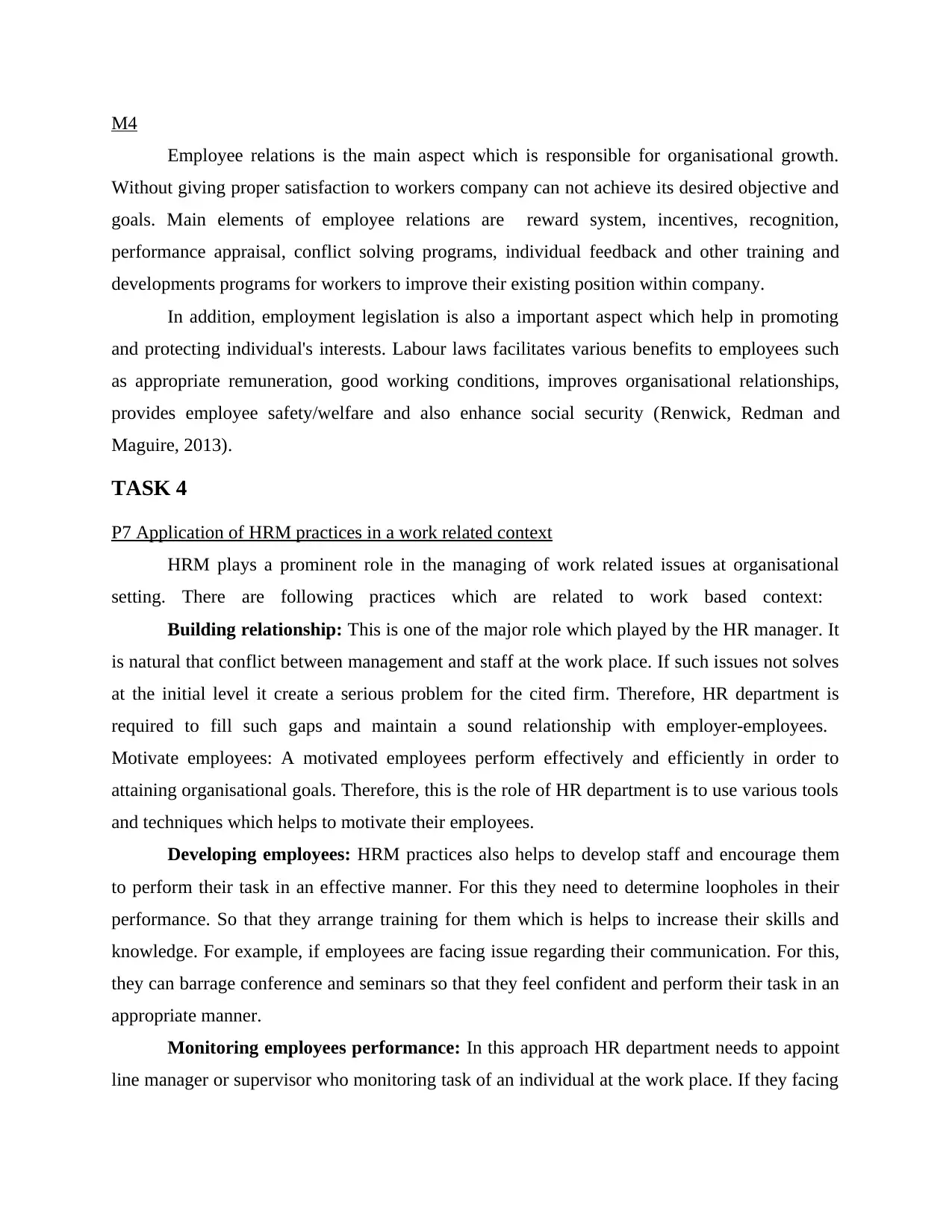
M4
Employee relations is the main aspect which is responsible for organisational growth.
Without giving proper satisfaction to workers company can not achieve its desired objective and
goals. Main elements of employee relations are reward system, incentives, recognition,
performance appraisal, conflict solving programs, individual feedback and other training and
developments programs for workers to improve their existing position within company.
In addition, employment legislation is also a important aspect which help in promoting
and protecting individual's interests. Labour laws facilitates various benefits to employees such
as appropriate remuneration, good working conditions, improves organisational relationships,
provides employee safety/welfare and also enhance social security (Renwick, Redman and
Maguire, 2013).
TASK 4
P7 Application of HRM practices in a work related context
HRM plays a prominent role in the managing of work related issues at organisational
setting. There are following practices which are related to work based context:
Building relationship: This is one of the major role which played by the HR manager. It
is natural that conflict between management and staff at the work place. If such issues not solves
at the initial level it create a serious problem for the cited firm. Therefore, HR department is
required to fill such gaps and maintain a sound relationship with employer-employees.
Motivate employees: A motivated employees perform effectively and efficiently in order to
attaining organisational goals. Therefore, this is the role of HR department is to use various tools
and techniques which helps to motivate their employees.
Developing employees: HRM practices also helps to develop staff and encourage them
to perform their task in an effective manner. For this they need to determine loopholes in their
performance. So that they arrange training for them which is helps to increase their skills and
knowledge. For example, if employees are facing issue regarding their communication. For this,
they can barrage conference and seminars so that they feel confident and perform their task in an
appropriate manner.
Monitoring employees performance: In this approach HR department needs to appoint
line manager or supervisor who monitoring task of an individual at the work place. If they facing
Employee relations is the main aspect which is responsible for organisational growth.
Without giving proper satisfaction to workers company can not achieve its desired objective and
goals. Main elements of employee relations are reward system, incentives, recognition,
performance appraisal, conflict solving programs, individual feedback and other training and
developments programs for workers to improve their existing position within company.
In addition, employment legislation is also a important aspect which help in promoting
and protecting individual's interests. Labour laws facilitates various benefits to employees such
as appropriate remuneration, good working conditions, improves organisational relationships,
provides employee safety/welfare and also enhance social security (Renwick, Redman and
Maguire, 2013).
TASK 4
P7 Application of HRM practices in a work related context
HRM plays a prominent role in the managing of work related issues at organisational
setting. There are following practices which are related to work based context:
Building relationship: This is one of the major role which played by the HR manager. It
is natural that conflict between management and staff at the work place. If such issues not solves
at the initial level it create a serious problem for the cited firm. Therefore, HR department is
required to fill such gaps and maintain a sound relationship with employer-employees.
Motivate employees: A motivated employees perform effectively and efficiently in order to
attaining organisational goals. Therefore, this is the role of HR department is to use various tools
and techniques which helps to motivate their employees.
Developing employees: HRM practices also helps to develop staff and encourage them
to perform their task in an effective manner. For this they need to determine loopholes in their
performance. So that they arrange training for them which is helps to increase their skills and
knowledge. For example, if employees are facing issue regarding their communication. For this,
they can barrage conference and seminars so that they feel confident and perform their task in an
appropriate manner.
Monitoring employees performance: In this approach HR department needs to appoint
line manager or supervisor who monitoring task of an individual at the work place. If they facing
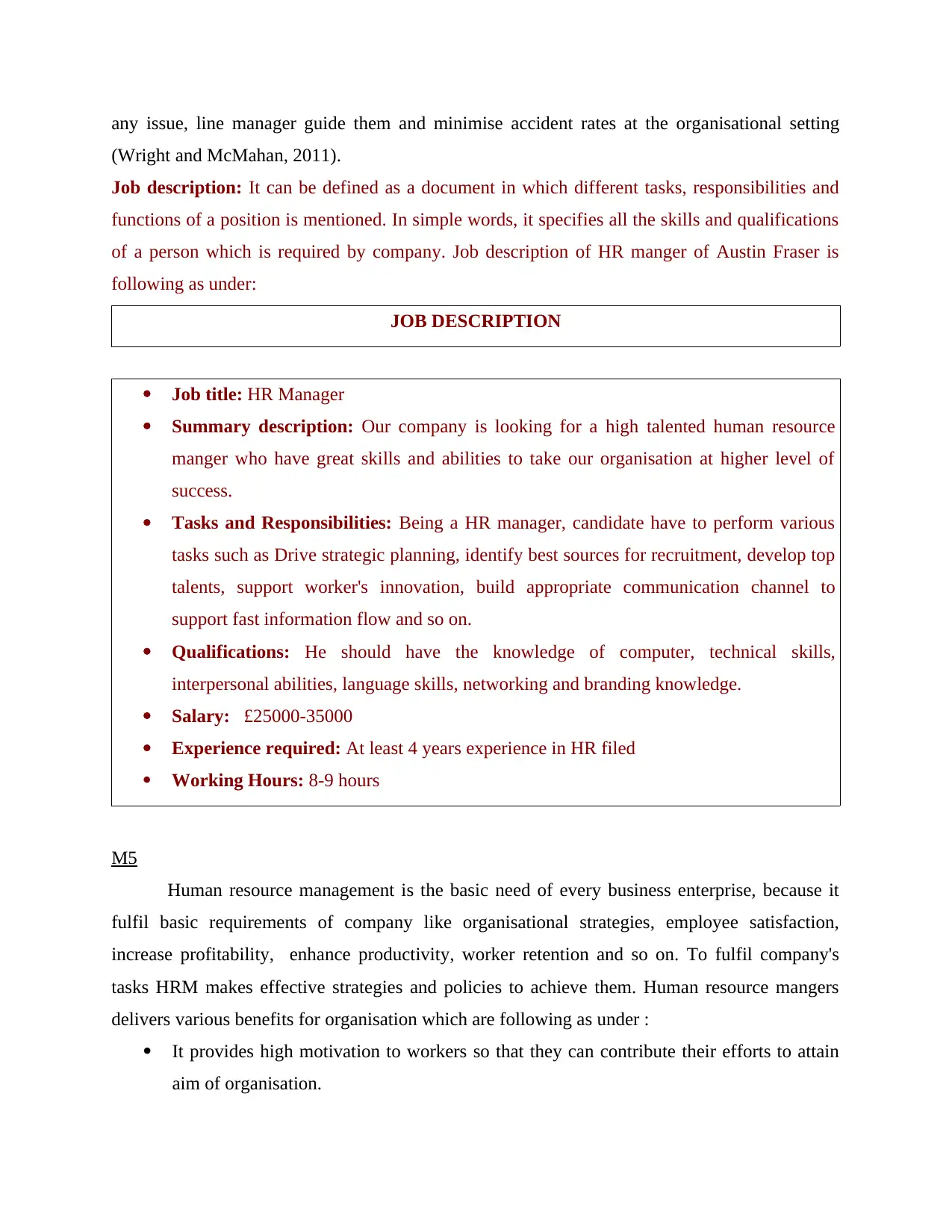
any issue, line manager guide them and minimise accident rates at the organisational setting
(Wright and McMahan, 2011).
Job description: It can be defined as a document in which different tasks, responsibilities and
functions of a position is mentioned. In simple words, it specifies all the skills and qualifications
of a person which is required by company. Job description of HR manger of Austin Fraser is
following as under:
JOB DESCRIPTION
Job title: HR Manager
Summary description: Our company is looking for a high talented human resource
manger who have great skills and abilities to take our organisation at higher level of
success.
Tasks and Responsibilities: Being a HR manager, candidate have to perform various
tasks such as Drive strategic planning, identify best sources for recruitment, develop top
talents, support worker's innovation, build appropriate communication channel to
support fast information flow and so on.
Qualifications: He should have the knowledge of computer, technical skills,
interpersonal abilities, language skills, networking and branding knowledge.
Salary: £25000-35000
Experience required: At least 4 years experience in HR filed
Working Hours: 8-9 hours
M5
Human resource management is the basic need of every business enterprise, because it
fulfil basic requirements of company like organisational strategies, employee satisfaction,
increase profitability, enhance productivity, worker retention and so on. To fulfil company's
tasks HRM makes effective strategies and policies to achieve them. Human resource mangers
delivers various benefits for organisation which are following as under :
It provides high motivation to workers so that they can contribute their efforts to attain
aim of organisation.
(Wright and McMahan, 2011).
Job description: It can be defined as a document in which different tasks, responsibilities and
functions of a position is mentioned. In simple words, it specifies all the skills and qualifications
of a person which is required by company. Job description of HR manger of Austin Fraser is
following as under:
JOB DESCRIPTION
Job title: HR Manager
Summary description: Our company is looking for a high talented human resource
manger who have great skills and abilities to take our organisation at higher level of
success.
Tasks and Responsibilities: Being a HR manager, candidate have to perform various
tasks such as Drive strategic planning, identify best sources for recruitment, develop top
talents, support worker's innovation, build appropriate communication channel to
support fast information flow and so on.
Qualifications: He should have the knowledge of computer, technical skills,
interpersonal abilities, language skills, networking and branding knowledge.
Salary: £25000-35000
Experience required: At least 4 years experience in HR filed
Working Hours: 8-9 hours
M5
Human resource management is the basic need of every business enterprise, because it
fulfil basic requirements of company like organisational strategies, employee satisfaction,
increase profitability, enhance productivity, worker retention and so on. To fulfil company's
tasks HRM makes effective strategies and policies to achieve them. Human resource mangers
delivers various benefits for organisation which are following as under :
It provides high motivation to workers so that they can contribute their efforts to attain
aim of organisation.
⊘ This is a preview!⊘
Do you want full access?
Subscribe today to unlock all pages.

Trusted by 1+ million students worldwide
1 out of 14
Related Documents
Your All-in-One AI-Powered Toolkit for Academic Success.
+13062052269
info@desklib.com
Available 24*7 on WhatsApp / Email
![[object Object]](/_next/static/media/star-bottom.7253800d.svg)
Unlock your academic potential
Copyright © 2020–2025 A2Z Services. All Rights Reserved. Developed and managed by ZUCOL.




